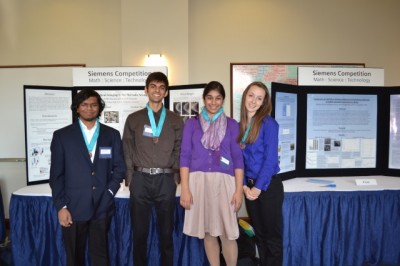
The nation’s premier young minds came together Nov. 8-10, in six universities around the country to participate in the prestigious Siemens Competition. These universities hosted the student competitors for the regional competition, which was comprised of five individuals and five teams from the region. Students presented their research in a poster and oral presentation for a chance to go to the national finals in Washington D.C. the first week of December.The regional finalists from RBHS traveled to the University of Notre Dame in South Bend, Ind., where they joined 11 other finalists from around the Midwest. Seniors Nidhi Khurana, Raj Satpathy, Katelyn Race and Atreyo Ghosh represented Missouri in the team competition.
“The competition was an incredible experience. Going there and meeting the people from our region, as the Siemens people said, the ‘brightest of the future scientists in the world,’ meeting these kids and seeing the potential, and the brains and the abilities of all these other students,” Khurana said. “It was an amazing feeling to be among those bright minds.”
Khurana and Satpathy presented their research on use of a barcode scanner for biomedical imaging, with a focus on cancer diagnosis and the reduction of overall cost of biomedical imaging. Race and Ghosh presented research on the use of an inexpensive, biodegradable adsorbent to remove arsenic contaminants from ground water in Third World countries. Other students presented research on topics from the modification of solar energy cells to the creation of software to diagnose cancerous bladder cells, in hopes of furthering and helping humanity.
“We envisioned the product we designed to eventually make it so individual families in Third World countries … could have a form of water purification,” Race said. “In Third World countries, having contaminated water, besides hurting their health, it hurts their overall development and ability to get out of poverty.”
The goal of the Siemens Foundation is to encourage science, technology, engineering and mathematics education in high school students, and as a result, the regional finalists presented their posters on Nov. 9 to students from schools in the area, as well as students from the University of Notre Dame. A number of scientists from the University of Notre Dame and high-ranking employees from Siemens delivered speeches and keynote addresses to the competitors and their families. Throughout the competition, the finalists forged close ties and lasting friendships.
“I made a lot of good friends,” Race said. “I was actually expecting a lot of cutthroat competition … but it was all really one big friendship group and we were all really sad to leave.”
Ultimately, juniors Dan Fu and Patrick Tan from Carmel, Ind., won the team division, with their project on using mathematical equations for modeling oscillations in biological processes, and Senior James Howe from Iowa City, Iowa, won the individual division, with a project on diagnosis of juvenile polyposis. The Siemens Foundation awarded all competitors with plaques and medals, alongside a $1,000 scholarship, while Fu, Tan and Howe won an additional $3,000 scholarship. Siemens Foundation chairman Tom McCausland was present throughout the competition to deliver remarks.
“I think that what we like to do is create an atmosphere that folks like the competitors, regional finalists, have an opportunity to showcase what they’ve done,” McCausland said. “To us, we’ve been told by young people that the most important things for them is have a community of like-minded friends that they can share experiences with, be recognized for their ability in science and math and academics and have a field of competition, so that they can test themselves in a friendly manner against each other.”
By Atreyo Ghoshadditional reporting by Raj Satpathy













































































Humera Lodhi • Nov 19, 2012 at 8:14 pm
Yeyy!! Good work
Very inspiring. Good on them for participating and doing so well.
Maria Kalaitzandonakes • Nov 14, 2012 at 10:02 am
I am so proud of these students You are all amazing!
You are all amazing!